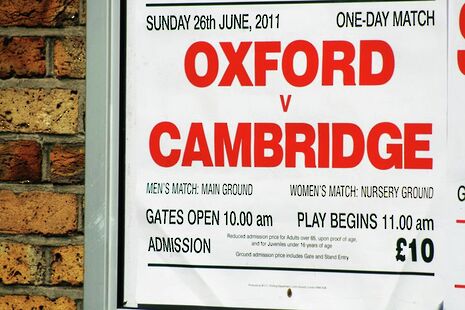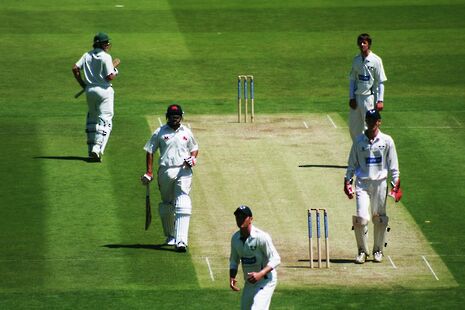Varsity joy for Cambridge cricketers
In a year where Cambridge failed to record Varsity success in any other major sport, its cricketers claim a remarkable clean-sweep of triumphs in Twenty20, at Lord’s, and in the first-class match at Fenner’s
It has not happened before; it may not happen again. In a year where Cambridge failed to record Varsity success in any other major sport, its cricketers claimed a remarkable clean-sweep of triumphs in Twenty20, at Lord’s, and in the first-class match at Fenner’s.

This was not, perhaps, surprising: from 2010 there remained eight Blues to which was added a precociously talented roster of freshers, among them Zafar Ansari (Surrey) and Paul Best (Warwickshire), both England U-19 and county 1st XI cricketers. Under the leadership of Richard Timms, himself a former professional with Somerset, the Light Blues would have a season of matchless drama, of incomparable Varsity success.
First, the university’s cricket week was given the perfect finale as Dan Goodwin and Phil Ashton steered Cambridge to a tense victory in the CharlesRussell Twenty20. Oxford had set a target of just 108, but Cambridge had collapsed to 90 for 7; still, smart running and a monstrous six from Ashton returned the CharlesRussell Trophy to Fenner’s. Earlier, Best had underlined his quality with a stand-out spell of 4 for 12 – his left-arm spin having become a perennial of the Fenner’s ground – but at Lord’s it was the Warwickshire man’s bat that provided the difference.
With Cambridge batting first, Zafar Ansari’s half-century – well supported by Anand Ashok and Phil Hughes – had laid the platform for a par total; that Cambridge would reach as many as 265 was due purely to the thirty balls from which Best would smite 63 (eight fours, two sixes). A brace of victims for Thomas Probert and Matt Hickey soon put Oxford behind the game; a miserly spell from Ansari turned the screw, while three wickets for Frankie Brown concluded affairs as Cambridge retained the CB Fry Trophy.

Finally, in the four-day fixture at Fenner’s, which many observers still regard as the Varsity match, the strength of the Blues was fully revealed. Without Ansari – on Twenty20 and frequently televised duty for Surrey – Cambridge had been reduced to 163 for 7 on the first afternoon, but 36 from Ashton, 54 from Hickey, and 36 from Paddy Sadler improved affairs to 280 all out. In Oxford’s reply, Best again bowled with immaculate control to take 3 for 45, while Probert ran through the tail to claim career-best figures of 4 for 20: Oxford 138 all out, and Cambridge with a lead of 142.
Yet, when stumbling to 51 for 5 on the second evening, the Light Blue hat-trick was far from secure: what it took was a mature half-century from Gus Kennedy, remarkable attrition from Tom Deasy, and another cameo from Hickey to set Oxford 326.
With Oxford four down within an hour, the result seemed assured: Hickey had struck twice with the new ball, Best twice from first change. However, a composed and almost heroic century from Oxford captain Rajiv Sharma delayed celebration: first, with Olly Richards, he put on 80; then, following another flurry of wickets – three more to Best – Sharma added 88 with Sam Westaway for the ninth wicket. The former, though, fell for 112 in the end. The last pair hung around a while longer when, with the requirement reduced to 56, Westaway left a straight ball from Frankie Brown: on the fourth morning, Cambridge achieved the first hat-trick in the history of Varsity cricket.
Blues skipper Timms, re-elected for the 2012 season, was understandably delighted with the results of the season: ‘Although we were the better team on paper, it’s another matter to get the job done across three separate formats and over six days of cricket’.
More pointedly, Timms rejoiced in the contributions of those who might not often receive the plaudits. ‘The season’s success was a real team effort’, he told Varsity Sport; ‘Gus Kennedy made sixty vital runs when we needed them in the four-dayer, and he then took five catches in the second innings, a couple of which were high class. Seamers Thomas Probert and Paddy Sadler were very reliable all year, while Matt Hickey bowled a beautiful spell at Lord's. Runs came from all the batsmen at different times, too’.
Of his own contributions, the skipper remained modestly silent. While runs may not have flowed from his bat in Varsity cricket, his 160 against MCC ensured preparations concluded successfully, while his unbeaten 146 against Oxford Brookes guaranteed promotion from the Blues’ BUCS league. Moreover, the creation of a tightly-knit and cohesive squad, disciplined and well led, can never be undervalued.
The achievements of Best and Ansari in greener and professional fields may remind us that Varsity sport remains a peculiar beast: no longer defined by national standards or by international excellence, its sole arbiter of success is performance against Oxford. Still, by that standard, few could question this vintage.
 Features / Should I stay or should I go? Cambridge students and alumni reflect on how their memories stay with them15 December 2025
Features / Should I stay or should I go? Cambridge students and alumni reflect on how their memories stay with them15 December 2025 News / Cambridge study finds students learn better with notes than AI13 December 2025
News / Cambridge study finds students learn better with notes than AI13 December 2025 Comment / The magic of an eight-week term15 December 2025
Comment / The magic of an eight-week term15 December 2025 News / News In Brief: Michaelmas marriages, monogamous mammals, and messaging manipulation15 December 2025
News / News In Brief: Michaelmas marriages, monogamous mammals, and messaging manipulation15 December 2025 News / Uni Scout and Guide Club affirms trans inclusion 12 December 2025
News / Uni Scout and Guide Club affirms trans inclusion 12 December 2025









